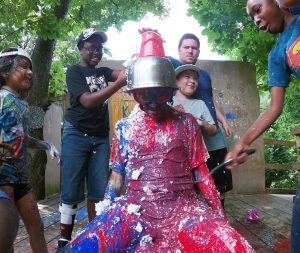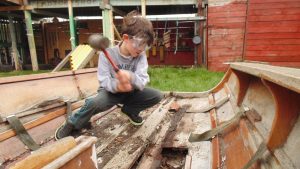An adventure playground at its heart belongs to the children who use it. They are places for children to test themselves, be loud, be messy, be silly, be creative… all the stuff that kids excel in. Here we look at some of the hallmarks of true adventure playgrounds.
1. Adventure playgrounds have three core ‘frees’:
Free of charge
Adventure playgrounds do not (as a rule) charge an entrance fee. This ensures that no child, regardless of economic circumstance, is excluded. However some specialist playgrounds for disabled children levy a charge to cover higher staff ratios and in these days of austerity, some playgrounds have been forced to introduce fees, usually only for those who are able to contribute.
Free to come and go
Adventure playgrounds are (generally) ‘open access’. This means children are free to come and go as they please during opening hours. Again, there are some exceptions – open access usually applies to over 6s only and specialist playgrounds may not operate like this. Open access provision is particularly good at reaching marginalised children, meaning that adventure playground staff are sometimes the only professionals in the lives of vulnerable families.
Free to choose
Adventure playgrounds offer children the opportunity to direct their own play. Free play is how children understand the world around them, how they learn social, conceptual and creative skills. The benefits of free play in childhood – to children, families and communities – continue throughout life, in how we become socially conscious adults, able to relate to and work with others.
Further reading:
2. Adventure playgrounds are staffed by skilled playworkers.
Adventure playgrounds are often located in economically deprived neighbourhoods where children can have difficult or complex lives. An adventure playground offers children a safe haven with trusted adults who will listen to and be interested in the children as people and the ideas they bring. Playworkers are not working to any agenda or specific outcomes; they are interested only supporting the child, on the child’s own terms. They are therefore often better at engaging kids who are marginalised or socially excluded than other more formal provision.
The goal of an adventure playworker is to facilitate children’s play, not to direct it. John Bertlesen, the ‘first playworker’ had this to say about the role:
“I cannot, and indeed will not, teach the children anything. I am able to give them my support in their creative play and work, and thus help them in developing those talents and abilities which are often suppressed at home and at school. I consider it most important that the leader not appear too clever but that he remain at the same experimental stage as the children. In this way the initiative is left, to a great extent, with the children themselves and it is thus far easier to avoid serious intrusion into their fantasy world.”
Austerity has seen local authority budgets shrink, and charities competing for ever-decreasing pots of money – and the temptation to try and save money by replacing staffed playgrounds with fixed equipment playgrounds has seen many much-loved spaces disappear. But this is a false economy, in both the short and the long term, the social impact of adventure playgrounds – on children’s future life chances as well as on the opportunities for staff and volunteers in the community – has been found to deliver economic benefits to the degree that ‘every £1 invested in an adventure playground generates an estimated £1.32 in social benefits’ over a 20-year period. Every £1 invested in qualified playwork staff generates an estimated £200 in social benefits over the same period. As the research states, ‘stopping investment in adventure playgrounds … with qualified personnel would result in more costs than are saved’ (Matrix, 2010).
Further reading:
3. Adventure playgrounds embrace the benefits of risk
Children and young people need to learn to assess and manage risks, not be insulated from them entirely. In doing so, they develop self esteem, confidence, and resilience: ‘I can do this’. Adventure playgrounds provide an environment where children can experiment, push their boundaries, try and fail, and try again. Adventure play workers are masters at weighing risks against the considerable benefits that exposure to risk can bring:
“The difference between risk and hazard: a risk you take on knowingly; a hazard is unexpected, like a nail sticking out of a board. The play workers are there to remove hazards and leave the risks.”
Play worker, The Land Adventure Playground, Wales
“[We have an] understanding of risk and the importance of managing it – rather than pretending that it can always be avoided. Adventurous play for children isn’t just great fun and immediately enjoyable. It doesn’t just bring the immediate benefits of activity, exercise and engagement with other children. Those shrieks of delight relate to the pleasures of energetic play, but they also signal some deep learning about capability, self-reliance, cooperation and the many other benefits that adventure playgrounds provide. ”
Lawrence Waterman OBE, Chair of the British Safety Counci
Ellen Sandseter, a professor at Queen Maud University in Trondheim, Norway, has identified six categories of risks that seem to attract children everywhere in their play. These are:
- Great heights: children climb trees and other structures to scary heights, from which they gain a birds-eye view of the world and the thrilling feeling of I did it!
- Rapid speeds: children swing on vines, ropes, or playground swings; slide on sleds, skis, skates, or playground slides; shoot down rapids on logs or boats; and ride bikes, skateboards, and other devices fast enough to produce the thrill of almost (but not quite) losing control.
- Dangerous tools: depending on the culture, children play with knives, bows and arrows, farm machinery (where work and play combine), or other tools known to be potentially dangerous. There is, of course, great satisfaction in being trusted to handle such tools, but there is also thrill in controlling them, knowing that a mistake could hurt.
- Dangerous elements: children love to play with fire, or in and around deep bodies of water, either of which poses some danger.
- Rough and tumble: children everywhere chase one another around and fight playfully, and they typically prefer being in the most vulnerable position—the one being chased or the one underneath in wrestling — the position that involves the most risk of being hurt and requires the most skill to overcome.
- Disappearing/getting lost: little children play hide and seek and experience the thrill of temporary, scary separation from their companions. Older ones venture off, on their own, away from adults, into territories that to them are new and filled with imagined dangers, including the danger of getting lost.
Peter Gray PhD: Risky Play: Why Children Love It and Need It
4. The Wild
Adventure playgrounds for the most part, are an urban phenomenon. They are often found nestled in the heart of housing estates, providing a wild space for kids who might not have a garden or even a balcony to play outside on. Adventure playgrounds give children the experience of the elements earth, air, fire and water in way that municipal parks do not.
Up until very recently in human evolution, the natural world of forests, lakes, moors and coastline has provided kids with a place to play, learn and develop. Adventure playgrounds attempt to give some of that wilderness back to children. As more of us live in cities than at any time in history, they compensate for the increasing loss of accessible natural space.
“An adventure playground can be described as a space dedicated solely to children’s play, where skilled playworkers enable and facilitate the ownership, development and design of that space – physically, socially and culturally – by the children playing there.”
Adventure Playgrounds: the essential elements, Play England 2009

‘The problem is that making things too safe can starve children of the very experiences that best help them learn how to keep themselves safe and healthy. As rising numbers of children and teenagers struggle with emotional and social problems, it is all the more important to get this balance right.
In the end, the only way children grow to be resilient – to be ready for the everyday challenges that life will inevitably throw at them – is by being given the freedom to learn from their own efforts, and their own mistakes.”
Tim Gill, author of No Fear: Growing up in a risk averse society

“Municipal playgrounds are often as bleak as barrack squares and just as boring. You are not allowed to build a fire, you would head straight for juvenile court if you started to dig up the expensive tarmac to make a cave, there are no bricks or planks to build a house, no workshops for carpentry, mechanical work, painting or modelling and of course, no trees to climb…”
Lady Allen of Hurtwood

